Lula Café was nearly full at lunchtime, but about half of the tables were taken by people eating alone. Some were working on crossword puzzles or reading the paper, a couple of others appeared to be writing poetry. It is the prototypical urban café: abstract art, drum-heavy world music, notices for upcoming theater and art events on a cluttered wall. The coffee is gourmet and the menu includes everything from sandwiches to Moroccan chickpeas with cous cous. The crowd was uniformly young, hip and white, and on this day included at least two musicians.
One was Eric Noden, a blues guitarist and singer who moved to Humboldt Park several years ago. He said there wasn’t a coffeehouse like this in his neighborhood, a largely Puerto Rican community directly south, so he made the trip to Lula Café, in Logan Square, for breakfast.
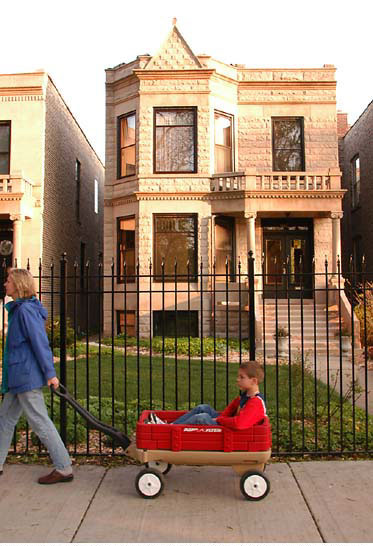 “There’s not too much around Humboldt, as far as hangout places,” Noden said. “Usually I come here to Logan or Wicker Park.”
“There’s not too much around Humboldt, as far as hangout places,” Noden said. “Usually I come here to Logan or Wicker Park.”
He moved to Humboldt Park because he found a spacious three-bedroom apartment in a nice two-flat for $600, the same amount he was paying for a cramped two-bedroom basement apartment in trendy Roscoe Village.
Five years ago, young artists like Noden in search of big space and dirt-cheap rent often moved to Logan Square, a mostly Latino neighborhood bounded roughly by Western, Armitage, Diversey and Pulaski. The area had a big stock of beautiful old flats with low rents. There were few amenities of the kind they liked, but Bucktown and Wicker Park, next door, were full of artsy bars, coffee shops, restaurants and record stores.
Today, bargain rents are the exception, not the rule, in Logan Square. People like Noden increasingly are moving to Humboldt Park for cheap rent and making the trip to Logan Square for coffee, eats and music. A handful of cheap and artsy places, not unlike the ones that popped up in Wicker Park during the ’80s, and a Starbucks have opened in Logan Square – the latest front in the westward wedge of gentrification.
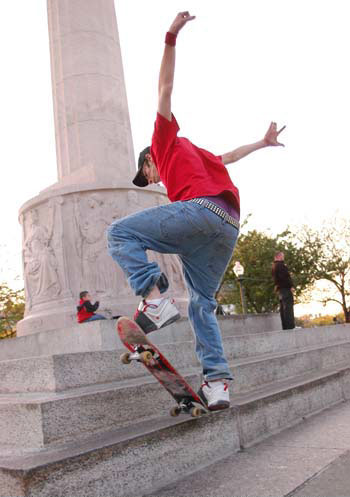 “You can definitely feel that (gentrification) is happening,” said Lea Tshilds, co-owner with Jason Hammel of Lula Café. “But you don’t feel it in the restaurant.”
“You can definitely feel that (gentrification) is happening,” said Lea Tshilds, co-owner with Jason Hammel of Lula Café. “But you don’t feel it in the restaurant.”
Tshilds said that as one of a handful of restaurants in Logan Square not serving Latin food, Lula has done well since it opened a few years ago.
A customer with long black hair who insisted his name was “Johnny Dollar,” said that Logan Square would not gentrify the way Wicker Park has.
“This neighborhood has more of a middle class base – not a high influx of yuppies,” Johnny Dollar said. “There are a lot of families who have lived here for a long time. Well, there were in Wicker Park too, I guess, but they were pushed out. I doubt that will happen here.”
Mr. Dollar didn’t say why the same process that sent property values through the roof in Bucktown and Wicker Park and caused large-scale displacement wouldn’t occur in Logan Square, but he seemed certain of it, as only a longtime resident could be.
Towards the end of a conversation, though, he admitted that he had lived in Logan Square for only six months. He moved there from Wicker Park in much the same way that the artsy types priced out of other neighborhoods moved to Wicker Park during the ’80s.
The westward push
Rising prices in Bucktown and Wicker Park have caused a growing number of renters, home buyers and developers to look at Logan Square. The neighborhood, in fact, is awash in a wave of condo conversions, and occasional upscale new construction developments – unheard of a decade ago in Logan – also are underway. A number of builders now market projects in Logan Square as being located in “West Bucktown.”
“Recently we’ve felt a lot of pressures from gentrification and displacement,” said Juan Rivera, executive director of the Latin United Community Housing Association, or LUCHA. “A lot of people with more resources are coming in, especially in West Town and Logan Square. Humboldt Park is a little more stable.”
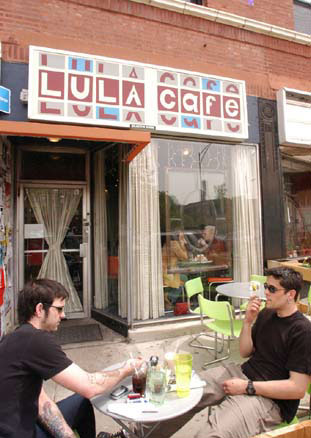 Rivera said that neighborhood rents doubled during just a few years at the end of the ’90s in Logan Square, where they continue to rise. The price and number of new condos also have risen sharply. Around 423 condos were sold in Logan Square last year, 130 percent more than in 1997. By comparison, only eight condos changed hands in the neighborhood during 1993.
Rivera said that neighborhood rents doubled during just a few years at the end of the ’90s in Logan Square, where they continue to rise. The price and number of new condos also have risen sharply. Around 423 condos were sold in Logan Square last year, 130 percent more than in 1997. By comparison, only eight condos changed hands in the neighborhood during 1993.
“I think it is an issue of pricing,” one real estate broker said. “Prices in Lincoln Park and DePaul and even Bucktown have been skyrocketing so much that you can just get a lot more bang for the buck in Logan Square.”
Jameson sales agent Barbara Buchel has lived in Logan Square, on Palmer Boulevard, for 17 years. She moved there from Lincoln Park after “falling in love with the architecture.” Both Logan Square and Humboldt Park are home to beautiful greystones and mansions and wide, grassy boulevards – remnants of the days when city planning was an art. Humboldt Park, which features a meandering lagoon and a number of stately buildings, is one of the city’s nicest. The square in Logan Square, ornate with flowerbeds and decorative lighting, is capped with a soaring monument that looms in the distance as you drive west down stately Logan Boulevard.
Buchel said that in Logan Square she sells to a large number of people moving to Chicago from out of town, as well as locals in search of more affordable pastures. But the pastures no longer offer the deals they once did. Prices on new condos in Logan Square are starting to catch up with those in Bucktown, according to Buchel.
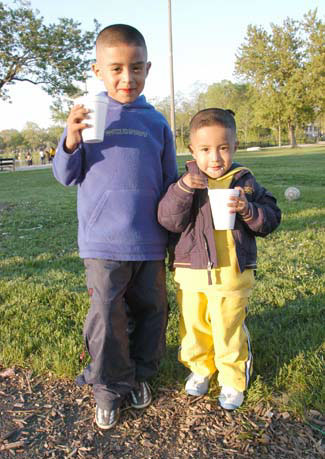 “Condominiums here are only running maybe $20 to $25 a square foot less than in Bucktown, depending on the development,” Buchel said. “There are no more bargain days in Logan. We have little vacant land available, and the existing structures have such gorgeous architecture that you can’t knock them down.”
“Condominiums here are only running maybe $20 to $25 a square foot less than in Bucktown, depending on the development,” Buchel said. “There are no more bargain days in Logan. We have little vacant land available, and the existing structures have such gorgeous architecture that you can’t knock them down.”
Coldwell Banker agent Maggie Milgrom said that three years ago, the first developments she sold in Logan Square offered rehabbed condos in the $80s and $90s. Today, she said, those same units are selling for $40,000 to $45,000 more. Milgrom currently is selling condo conversions on Palmer and Belden priced from the $150s to the $260s. The one- and two-bedroom units come with the sort of high-end finishes developers offer along the lakefront – stainless steel appliances, granite counters, maple or cherry cabinets, marble or granite counters – but at a much lower cost, according to Milgrom.
“In Lincoln Park, properties were being sold in the $200s for a one-bedroom,” Milgrom said. “Here you can get a two-bedroom two-bath (condo) with all the bells and whistles for $235,000. Some remarks I’ve heard were that you couldn’t touch these types of finishes for this price in Lincoln Park.”
Such projects are testing a new high-end in Logan Square and are wildly unaffordable to most residents. Despite rising property values and an influx of residents with more money, Logan Square remains a low-income community. According to the city’s 1995 estimate, the neighborhood is about 68 percent Latino. Many of the current residents came to Logan Square, which also has Polish roots, after being displaced from lakefront neighborhoods.
“Logan Square right now is feeling a tremendous amount of pressure because there have been such an escalation of land costs and so many conversions, so people are feeling the pinch in ways they hadn’t before,” said Joy Aruguete, executive director of Bickerdike Redevelopment Corp., a non-profit group that develops affordable housing for rent and for sale in West Town, Humboldt Park, Hermosa and Logan Square. “The people being pushed out are people who have lived there generations. In Logan Square and East Humboldt Park, and even in West Humboldt Park, there’s no denying what’s going on. The community is gentrifying.”
Hope in Humboldt
The Puerto Rican Cultural Center opened at 1671 N. Claremont, in the neighborhood now known as Bucktown, in 1976. Today, it seems like a strange location for the center, surrounded by gourmet restaurants, expensive bars, mainly Anglo residents and new lofts and townhouses that sell for a quarter of a million dollars at the low end.
For Jose Lopez, the center’s executive director, the evolution of Bucktown is a valuable lesson.
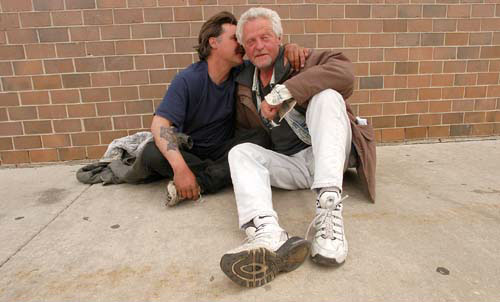 “The neighborhood has completely changed,” said Lopez, whose family came to Chicago from Puerto Rico in 1959. “When we bought that property it was predominantly a Puerto Rican and Latino community. Now there are almost no Puerto Ricans left, and the cost of living there is extremely high.”
“The neighborhood has completely changed,” said Lopez, whose family came to Chicago from Puerto Rico in 1959. “When we bought that property it was predominantly a Puerto Rican and Latino community. Now there are almost no Puerto Ricans left, and the cost of living there is extremely high.”
As the neighborhood changed, the center faced new challenges to serving its constituents.
“We felt alienated from our neighbors, and a lot of problems emerged,” Lopez said. “We take clear political positions, and they actually started a campaign to get rid of our murals. Our building had murals on it, and others, our students had done outside… The police were calling on our kids because people felt threatened. The whole cultural dimension was difficult.”
If gentrification was a threat to the center, however, it also provided a solution of sorts. Lopez shopped the center’s site with several real estate developers and eventually arrived at a creative deal with SBS Development. SBS paid a fixed price for the valuable property at 1671 N. Claremont and in addition, cut in the Puerto Rican Cultural Center for a percentage of each condo it will build and sell on the site.
SBS Development meanwhile served as developer for a new Puerto Rican Cultural Center, which opened at 2739 W. Division at the end of March, financed with proceeds from the sale of the Bucktown site. Property costs in Humboldt Park, where the new center is located, are much lower than in Bucktown. But more important, the Near Northwest neighborhood is the heart of Chicago’s Puerto Rican community.
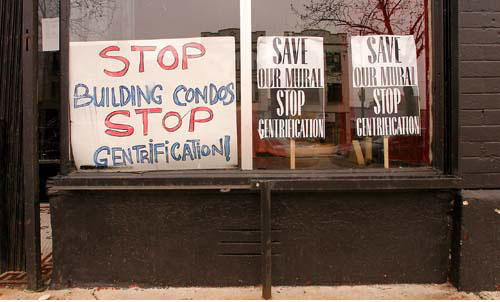 “We (moved) because this area is predominantly Puerto Rican,” Lopez said. “We do a lot of organizing and cultural work here, we have for many years. It’s facing the threat of gentrification, and we wanted to make a stand with the rest of the community, to maintain this area as a Puerto Rican-accented area.”
“We (moved) because this area is predominantly Puerto Rican,” Lopez said. “We do a lot of organizing and cultural work here, we have for many years. It’s facing the threat of gentrification, and we wanted to make a stand with the rest of the community, to maintain this area as a Puerto Rican-accented area.”
It was important, Lopez said, to be “between the flags,” a reference to the two giant steel Puerto Rican Flags that span Division Street at both ends of Humboldt Park. Directly east, in Wicker Park, Division Street is lined with new upscale restaurants and pricey condo buildings. West of Western Avenue, it is the most concentrated strip of Puerto Rican businesses in the city, a market known as Paseo Boricua.
Some have complained that the flags act as barriers to non-Puerto Ricans who want to move westward. Activists say the symbols are meant to be gateways to a vibrant community that has been forced west from other neighborhoods for decades and is determined to maintain its identity and housing in Humboldt Park.
That challenge is not as easy as it sounds. After a decade-long citywide real estate boom, housing prices are up across Chicago. The pressure is especially strong on Humboldt Park, which is surrounded by gentrified or rapidly gentrifying neighborhoods such as Logan Square, West Town, Wicker Park and Bucktown.
Lopez, however, is hopeful that a homegrown effort called the Humboldt Park Empowerment Program can preserve Humboldt Park’s stock of affordable housing and its cultural identity. The program includes a variety of groups working on cultural initiatives, organizing and developing affordable housing.
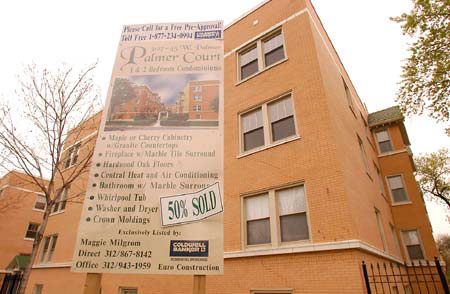 Market trends also provide some hope for neighborhood activists. The Chicago Association of Realtors recorded only five condo transactions in Humboldt Park during the last three years and none during the five before that, though some units may have changed hands outside the multiple listing service CAR uses to compile its statistics. In a real estate market full of double digit price increases, the median single-family house in Humboldt rose just 1.7 percent, to $115,000 in 2002, compared to $113,000 in 2001.
Market trends also provide some hope for neighborhood activists. The Chicago Association of Realtors recorded only five condo transactions in Humboldt Park during the last three years and none during the five before that, though some units may have changed hands outside the multiple listing service CAR uses to compile its statistics. In a real estate market full of double digit price increases, the median single-family house in Humboldt rose just 1.7 percent, to $115,000 in 2002, compared to $113,000 in 2001.
Groups such as LUCHA, Bickerdike and others also are working to preserve affordable housing in Humboldt Park.
Bickerdike recently built 14 affordable single-family homes and three owner-occupied two-flats around Humboldt Park, and at press time, was scheduled to close in June on financing for the Harold Washington Unity Co-op. The 87 co-op units will be developed in 18 new buildings designed to be affordable for residents at or below 50 percent of the metropolitan area’s median income.
Century Place Development Corp. has rehabbed the old Lion Hotel into Los Vecinos, a 66-unit SRO building that at press time, was scheduled to open in June. Fifty of the units will be Section 8 housing for those at risk of being homeless and another 12 will be subsidized for the working poor.
Such projects are important because they create housing that will remain affordable, but their waiting lists demonstrate how unaffordable Humboldt Park already has become for many residents. Century Place Development had more than 400 applications for 62 available units at Los Vecinos, according to Director of Real Estate Development Mark Marshall. Joy Aruguete, of Bickerdike, said that for developments that provide subsidies to tenants, she receives 1,000 calls within two days and has to cut off the phone lines.
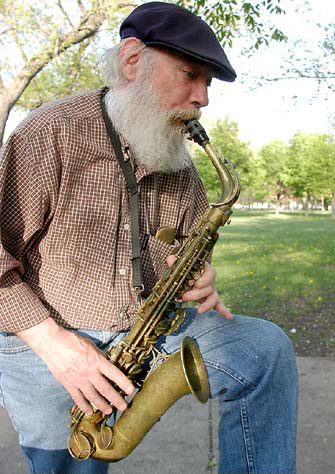 “Demand for affordable housing here has increased exponentially,” Aruguete said. “There’s less and less affordable housing in the community. For people trying to stay here, it’s a desperate struggle. People have doubled up or tripled up. Production doesn’t begin to meet demand.”
“Demand for affordable housing here has increased exponentially,” Aruguete said. “There’s less and less affordable housing in the community. For people trying to stay here, it’s a desperate struggle. People have doubled up or tripled up. Production doesn’t begin to meet demand.”
The Daley administration recognized the citywide affordable housing shortage recently when it wrote an ordinance requiring developers receiving city subsidies to set aside 20 percent of new units as affordable. That measure didn’t go as far as some activists and aldermen had hoped, but Aruguete said it marked important progress.
“A number of institutions will have to take a multi-faceted approach to this issue that will combine different programs,” Aruguete said. “Zoning policy or set-asides must be part of the plan, and this year there’s been a considerable amount of progress. It’s a broad problem, and it needs a broad solution.”
